Numerical Solution of the Fractional Partial Differential Equations by the Two-Dimensional Fractional-Order Legendre Functions
Abstract
A numerical method is presented to obtain the approximate solutions of the fractional partial differential equations (FPDEs). The basic idea of this method is to achieve the approximate solutions in a generalized expansion form of two-dimensional fractional-order Legendre functions (2D-FLFs). The operational matrices of integration and derivative for 2D-FLFs are first derived. Then, by these matrices, a system of algebraic equations is obtained from FPDEs. Hence, by solving this system, the unknown 2D-FLFs coefficients can be computed. Three examples are discussed to demonstrate the validity and applicability of the proposed method.
1. Introduction
Fractional partial differential equations play a significant role in modeling physical and engineering processes. Therefore, there is an urgent need to develop efficient and fast convergent methods for FPDEs. Recently, several different techniques, including Adomian’s decomposition method (ADM) [1, 2], homotopy perturbation method (HPM) [3–5], variational iteration method (VIM) [6–8], spectral methods [9–13], orthogonal polynomials method [14–17], and wavelets method [18–21] have been presented and applied to solve FPDEs.
The method based on the orthogonal functions is a wonderful and powerful tool for solving the FDEs and has enjoyed many successes in this realm. The operational matrix of fractional integration has been determined for some types of orthogonal polynomials, such as Chebyshev polynomials [16], Legendre polynomials [22], Laguerre polynomials [23–25], and Jacobi polynomials [26]. Moreover, the operational matrix of fractional derivative for Chebyshev polynomials [9] and Legendre polynomials [9, 14] also has been derived. However, since these polynomials using integer power series to approximate fractional ones, it cannot accurately represent properties of fractional calculus. Recently, Rida and Yousef [27] presented a fractional extension of the classical Legendre polynomials by replacing the integer order derivative in Rodrigues formula with fractional order derivatives. The defect is that the complexity of these functions made them unsuitable for solving FDEs. Subsequently, Kazem et al. [28] presented the orthogonal fractional order Legendre functions based on shifted Legendre polynomials to find the numerical solution of FDEs and drew a conclusion that their method is accurate, effective, and easy to implement.
Benefiting from their “exponential-convergence” property when smooth solutions are involved, spectral methods have been widely and effectively used for the numerical solution of partial differential equations. The basic idea of spectral methods is to expand a function into sets of smooth global functions, called the trial functions. Because of their special properties, the orthogonal polynomials are usually chosen to be trial functions. Spectral methods can obtain very accurate approximations for a smooth solution while only need a few degrees of freedom. Recently, Chebyshev spectral method [9], Legendre spectral method [10], and adaptive pseudospectral method [11] were proposed for solving fractional boundary value problems. Moreover, generalized Laguerre spectral algorithms and Legendre spectral Galerkin method were developed by Baleanu et al. [12] and Bhrawy and Alghamdi [13] for fractional initial value problems, respectively.
Motivated and inspired by the ongoing research in orthogonal polynomials methods and spectral methods, we construct two-dimensional fractional-order Legendre functions and derive the operational matrices of integration and derivative for the solution of FPDEs. To the best of the authors’ knowledge, such approach has not been employed for solving FPDEs.
The rest of the paper is organized as follows. In Section 2, we introduce some mathematical preliminaries of the fractional calculus theory and fractional-order Legendre functions. In Section 3, a basis of 2D-FLFs is defined and some properties are given. Section 4 is devoted to the operational matrices of fractional derivative and integration for 2D-FLFs. Some numerical examples are presented in Section 5. Finally, we conclude the paper with some remarks.
2. Preliminaries and Notations
2.1. Fractional Calculus Theory
Some necessary definitions and Lemma of the fractional calculus theory [29, 30] are listed here for our subsequent development.
Definition 1. A real function h(t), t > 0, is said to be in the space Cμ, μ ∈ R, if there exists a real number p > μ, such that h(t) = tph1(t), where h1(t) ∈ C(0, ∞), and it is said to be in the space if and only if h(n) ∈ Cμ, n ∈ N.
Definition 2. Riemann-Liouville fractional integral operator (Jα) of order α ≥ 0, of a function f ∈ Cμ, μ ≥ −1 is defined as
Definition 3. The fractional derivative of f(x) in the Caputo sense is defined as
Lemma 4. Let n − 1 < α ≤ n, n ∈ N, t > 0, , μ ≥ −1. Then
2.2. Fractional-Order Legendre Functions
3. 2D-FLFs
In this section, the definitions and theorems of 2D-FLFs are given by Liu’s method described in [31].
3.1. Definitions and Properties of the 2D-FLFs
Definition 5. Let be the fractional Legendre polynomials on [0,1]; we call the two-dimensional fractional Legendre polynomials on [0,1] × [0,1].
Theorem 6. The basis is orthogonal on [0,1] × [0,1] with the weight function ω(x, y) = ω(x)ω(y) = xα−1yβ−1.
Proof. Let i ≠ m or j ≠ n
Theorem 7. Consider
3.2. 2D-FLFs Expansion
Definition 8. A function of two independent variables f(x, y) which is integrable in square [0,1] × [0,1] can be expanded as
Theorem 9. If the series converges uniformly to f(x, y) on the square [0,1] × [0,1], then we have
Proof. By multiplying on both sides of (10), where n and m are fixed and integrating termwise with regard to x and y on [0,1] × [0,1], then
According to the definition of FLFs, one can find that fractional Legendre polynomials are identical to Legendre polynomials shifted to [0,1] when using the transform xα → x, yβ → y. Therefore, in a similar method described in [31], we can easily get the convergence and stability theorems of proposed method.
Lemma 10. If the function f(x, y) is a continuous function on [0,1] × [0,1] and the series converges uniformly to f(x, y), then is the 2D-FLFs expansion of f(x, y).
Proof (by contradiction). Let
Lemma 11. If two continuous functions defined on [0,1] × [0,1] have the identical 2D-FLFs expansions, then these two functions are identical.
Proof. Suppose that f(x, y) and g(x, y) can be expanded by 2D-FLFs as follows:
Theorem 12. If the 2D-FLFs expansion of a continuous function f(x, y) converges uniformly, then the 2D-FLFs expansion converges to the function f(x, y).
Theorem 13. If the sum of the absolute values of the 2D-FLFs coefficients of a continuous function f(x, y) forms a convergent series, then the 2D-FLFs expansion is absolutely uniformly convergent, and converges to the function f(x, y).
Proof. Consider
Theorem 14. If a continuous function f(x, y), defined on [0,1] × [0,1], has bounded mixed partial derivative , then the 2D-FLFs expansion of the function converges uniformly to the function.
4. Operational Matrices of 2D-FLFs
4.1. Integration Operational Matrices of 2D-FLFs
Lemma 15. The Riemann-Liouville fractional integration of order γ > 0 of the 2D-FLFs ψij can be obtained in the form of
Proof. Consider
Lemma 16. Let γ > 0; then one has
Theorem 17. Let Ψ(xα, yβ) be the 2D-FLFs vector defined in (16); then one has
Proof. Using (29) and orthogonality property of FLFs, one can get
Now by substituting above equations in (32), Theorem 12 can be proved.
In a similar way as previous, one can obtain the operational matrix of Riemann-Liouville fractional integration with respect to variable y.
Theorem 18. Let Ψ(xα, yβ) be the 2D-FLFs vector defined in (16); one has
4.2. Derivative Operational Matrices of 2D-FLFs
Lemma 19. The FLFs Caputo fractional derivative of γ > 0 can be obtained in the form of
Proof. Consider
Lemma 20. Let γ > 0, α ∉ N; then one has
Theorem 21. Let Ψ(xα, yβ) be the 2D-FLFs vector defined in (16); one has
Proof. Using (41) and the orthogonality property of FLFs, one can have
Now by substituting above equations in (44), Theorem 21 can be proved.
In a similar way as above, one can get Caputo fractional derivative of order γ > 0 with respect to variable y.
Theorem 22. Let Ψ(xα, yβ) be the 2D-FLFs vector defined in (16); one can have
5. Applications and Results
Example 23. Consider the one-dimensional linear inhomogeneous fractional Burger’s equation [35]:
By employing 2D-FLFs method, one can get
Figures 1(a) and 1(b) show the numerical results for β = 0.25 with m = 3, m′ = 9 and β = 0.5 with m = 3, m′ = 5, respectively. It should be found that the accuracy of 2D-FLFs method is very high while only a small number of 2D-FLFs are needed.
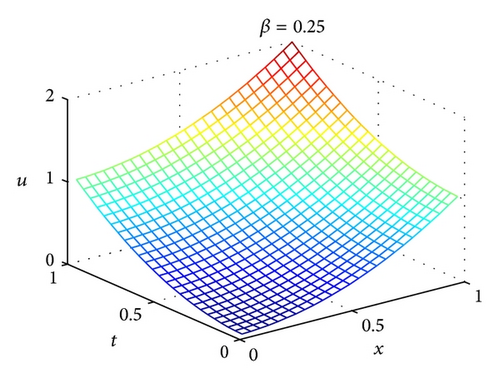
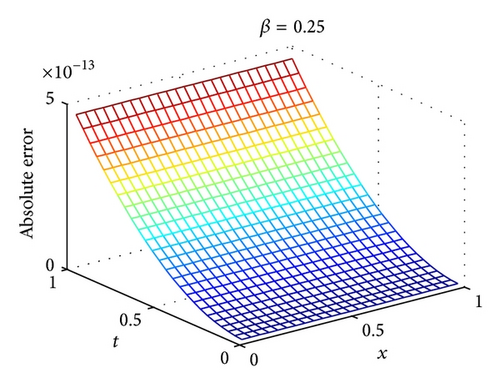
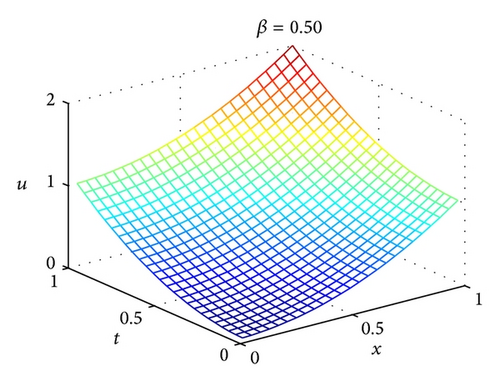

Example 24. Consider nonlinear fractional Klein-Gordon equation [36, 37]:
By employing 2D-FLFs method with m = 3 and m′ = 3, one can have
The numerical results of Example 24 for different values of α and β are shown in Figure 2. In addition, L2 and L∞ errors are presented in Table 1. From Table 1, one can conclude that the solutions of 2D-FLFs method are in good agreement with the exact results. Compared with homotopy analysis method (HAM) [36] and homotopy perturbation method (HPM) [37], 2D-FLFs method can get high accuracy solution while only need a few terms of 2D-FLFs.
| Error | α = β = 1.25 | α = β = 1.50 | α = β = 1.75 | α = β = 2.00 |
|---|---|---|---|---|
| L2 | 5.6437e − 015 | 1.2075e − 015 | 3.4584e − 015 | 8.9917e − 016 |
| L∞ | 4.4409e − 016 | 1.1102e − 016 | 3.3307e − 016 | 1.1102e − 016 |
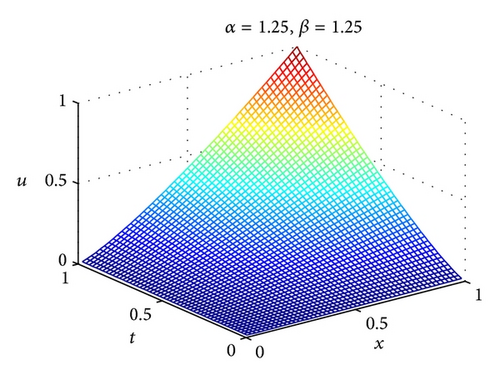
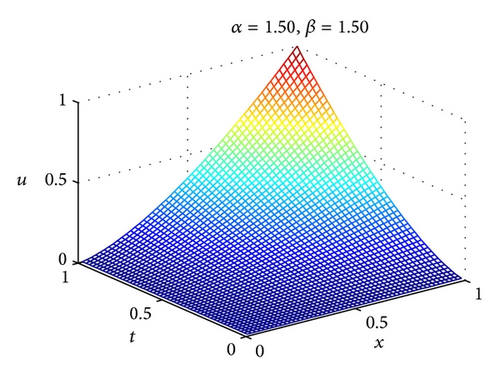
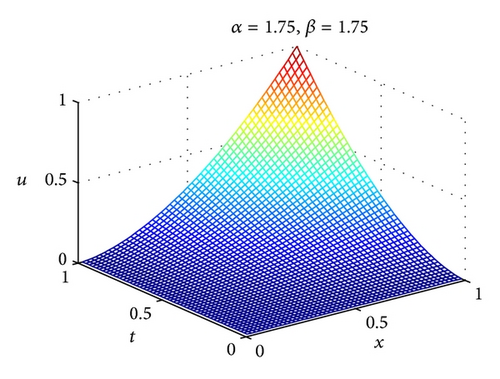
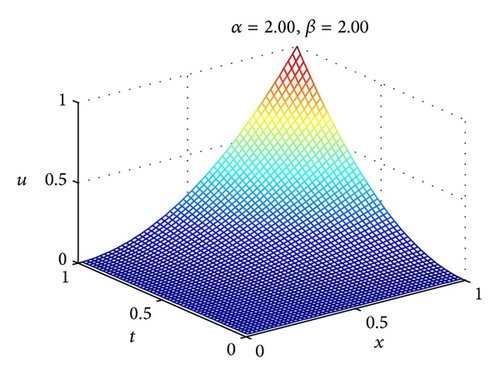
Example 25. Consider the nonlinear time-fractional advection partial differential equation [37–39]
Figure 3 gives the approximation solutions of (61) for β = 0.50 with m = 4, m′ = 5 and β = 0.75 with m = 4, m′ = 9. Moreover, Table 2 shows the approximate solutions for (61) obtained for different values of β using the fractional variational iteration method (FVIM) [39] and 2D-FLFs method. The values of β = 1 are the only case for which we know the exact solution u(x, t) = xt. It should be noted that only the fourth-order term of the FVIM was used in evaluating the approximate solutions for Table 2. From Table 2, it clearly appears that 2D-FLFs method is more accurate than FVIM and the obtained results are in good agreement with exact solution.
| t | x | β = 0.50 | β = 0.75 | β = 1.00 | ||||
|---|---|---|---|---|---|---|---|---|
| FVIM | 2D-FLFs | FVIM | 2D-FLFs | FVIM | 2D-FLFs | Exact | ||
| 0.25 | 0.25 | 0.12422501 | 0.12225461 | 0.09230374 | 0.09224583 | 0.06250058 | 0.062500 | 0.062500 |
| 0.50 | 0.24845002 | 0.24450922 | 0.18460748 | 0.18449165 | 0.12500117 | 0.125000 | 0.125000 | |
| 0.75 | 0.37267504 | 0.36676383 | 0.27691122 | 0.27673748 | 0.18750175 | 0.187500 | 0.187500 | |
| 1.00 | 0.49690005 | 0.48901844 | 0.36921496 | 0.36898331 | 0.25000234 | 0.250000 | 0.250000 | |
| 0.50 | 0.25 | 0.18377520 | 0.16584130 | 0.15148283 | 0.14985508 | 0.12507592 | 0.125000 | 0.125000 |
| 0.50 | 0.36755040 | 0.33168259 | 0.30296566 | 0.29971016 | 0.25015184 | 0.250000 | 0.250000 | |
| 0.75 | 0.55132559 | 0.49752389 | 0.45444848 | 0.44956524 | 0.37522776 | 0.375000 | 0.375000 | |
| 1.00 | 0.73510079 | 0.66336518 | 0.60593131 | 0.59942032 | 0.50030368 | 0.500000 | 0.500000 | |
| 0.75 | 0.25 | 0.27227270 | 0.20678964 | 0.21407798 | 0.20119503 | 0.18881843 | 0.187500 | 0.187500 |
| 0.50 | 0.54454540 | 0.41357929 | 0.42815596 | 0.40239005 | 0.37763687 | 0.375000 | 0.375000 | |
| 0.75 | 0.81681810 | 0.62036893 | 0.64223394 | 0.60358508 | 0.56645530 | 0.562500 | 0.562500 | |
| 1.00 | 1.08909080 | 0.82715857 | 0.85631192 | 0.80478011 | 0.75527373 | 0.750000 | 0.750000 | |
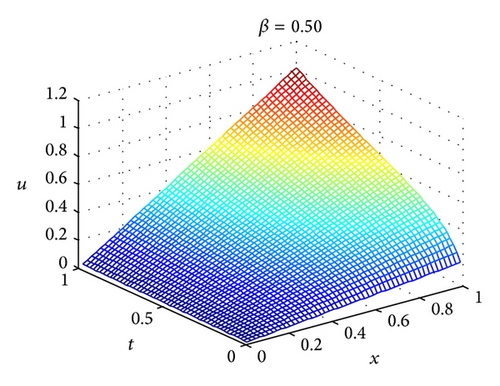

Example 26. We finally consider the linear time-fractional wave equation:
Table 3 gives a comparison of the approximate solutions at different values of β using the FVIM [39] and 2D-FLFs method. Figure 4 shows the numerical solutions of 2D-FLFs method for (63) at different values of β with m = 3, m′ = 9. The values of β = 1 are the only case for which we know the exact solution u(x, t) = x + x2sinh (t). As previous, only the fourth-order term of the FVIM was used in evaluating the numerical solutions for Table 3. In the case of β = 1, it can be found that absolute error of 2D-FLFs is not bigger than 1.0e − 10 which is very small compared with that obtained by FVIM.
| t | x | β = 0.750 | β = 0.875 | β = 1.000 | |||
|---|---|---|---|---|---|---|---|
| FVIM | 2D-FLFs | FVIM | 2D-FLFs | FVIM | Exact | ||
| 0.25 | 0.25 | 0.26622298 | 0.26622021 | 0.26593959 | 0.26594005 | 0.26578827 | 0.26578827 |
| 0.50 | 0.56489190 | 0.56488083 | 0.56375836 | 0.56376020 | 0.56315308 | 0.56315308 | |
| 0.75 | 0.89600678 | 0.89598187 | 0.89345630 | 0.89346046 | 0.89209443 | 0.89209443 | |
| 1.00 | 1.25956762 | 1.25952332 | 1.25503343 | 1.25504082 | 1.25261232 | 1.25261232 | |
| 0.50 | 0.25 | 0.28474208 | 0.28474415 | 0.28340402 | 0.28340659 | 0.28256846 | 0.28256846 |
| 0.50 | 0.63896831 | 0.63897662 | 0.63361610 | 0.63362636 | 0.63027383 | 0.63027383 | |
| 0.75 | 1.06267869 | 1.06269739 | 1.05063622 | 1.05065931 | 1.04311611 | 1.04311611 | |
| 1.00 | 1.55587323 | 1.55590647 | 1.53446439 | 1.53450544 | 1.52109530 | 1.52109531 | |
| 0.75 | 0.25 | 0.30690489 | 0.30690747 | 0.30361709 | 0.30361656 | 0.30139478 | 0.30139480 |
| 0.50 | 0.72761955 | 0.72762986 | 0.71446834 | 0.71446625 | 0.70557913 | 0.70557918 | |
| 0.75 | 1.26214400 | 1.26216719 | 1.23255378 | 1.23254905 | 1.21255304 | 1.21255316 | |
| 1.00 | 1.91047821 | 1.91051944 | 1.85787338 | 1.85786498 | 1.82231652 | 1.82231673 | |
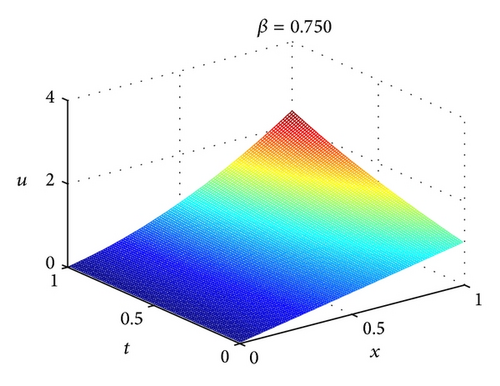

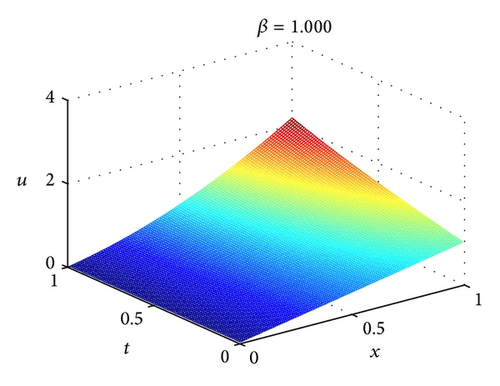
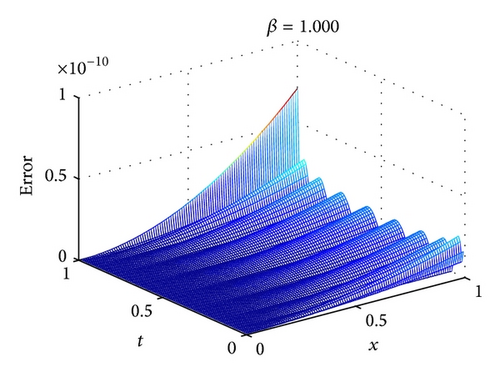
6. Conclusion
We define a basis of 2D-FLFs and derived its operational matrices of fractional derivative and integration, which are used to approximate the numerical solution of FPDEs. Compared with other numerical methods, 2D-FLFs method can accurately represent properties of fractional calculus. Moreover, only a small number of 2D-FLFs are needed to obtain a satisfactory result. The obtained results demonstrate the validity and applicability of proposed method for solving the FPFEs.
Acknowledgments
This work is supported by the National Natural Science Foundation of China (Grant no. 11272352). The authors are grateful to the anonymous referees for their comments which substantially improved the quality of this paper.




